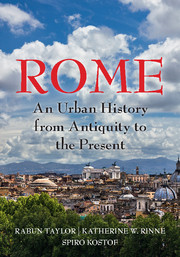Book contents
- Frontmatter
- Dedication
- Epigraph
- Contents
- List of Illustrations
- Acknowledgments
- Map
- INTRODUCTION
- 1 A BEND IN THE RIVER
- 2 A STORYBOOK BEGINNING
- 3 IDEOLOGICAL CROSSFIRE
- 4 BIG MEN ON THE CAMPUS
- 5 RES PUBLICA RESTITUTA
- 6 MEMORIALS IN MOTION: SPECTACLE IN THE CITY
- 7 THE CONCRETE STYLE
- 8 REMAKING ROME'S PUBLIC CORE: I
- 9 REMAKING ROME'S PUBLIC CORE: II
- 10 CRISIS AND CONTINUITY
- 11 RUS IN URBE: A GARDEN CITY
- 12 ADMINISTRATION, INFRASTRUCTURE, AND DISPOSAL OF THE DEAD
- 13 MAPPING, ZONING, AND SEQUESTRATION
- 14 TETRARCHIC AND CONSTANTINIAN ROME
- 15 TROPHIES AND TITULI: CHRISTIAN INFRASTRUCTURE BEFORE CONSTANTINE
- 16 WALLS MAKE CHRISTIANS: FROM FOURTH TO FIFTH CENTURY
- 17 A TALE OF TWO ROMES
- 18 THE ROME OF GOTHS AND BYZANTINES
- 19 CHRISTIAN FOUNDATIONS
- 20 FROM DOMUS LATERANI TO ROMANUM PALATIUM
- 21 THE LEONINE CITY: ST. PETER'S AND THE BORGO
- 22 VIA PAPALIS, THE CHRISTIAN DECUMANUS
- 23 THE URBAN THEATERS OF IMPERIUM AND SPQR
- 24 HOUSING DAILY LIFE
- 25 CHAOS IN THE FORTIFIED CITY
- 26 THE TIBER RIVER
- 27 HUMANIST ROME, ABSOLUTIST ROME (1420–1527)
- 28 PLANNING COUNTER REFORMATION ROME
- 29 PROCESSIONS AND POPULATIONS
- 30 MAGNIFICENT PALACES AND RHETORICAL CHURCHES
- 31 NEOCLASSICAL ROME
- 32 PICTURING ROME
- 33 REVOLUTION AND RISORGIMENTO
- 34 ITALIAN NATIONALISM AND ROMANITÀ
- 35 A CITY TURNED INSIDE OUT
- Glossary of Persons, Places, and Terms
- Works Cited
- Index
34 - ITALIAN NATIONALISM AND ROMANITÀ
Published online by Cambridge University Press: 05 July 2016
- Frontmatter
- Dedication
- Epigraph
- Contents
- List of Illustrations
- Acknowledgments
- Map
- INTRODUCTION
- 1 A BEND IN THE RIVER
- 2 A STORYBOOK BEGINNING
- 3 IDEOLOGICAL CROSSFIRE
- 4 BIG MEN ON THE CAMPUS
- 5 RES PUBLICA RESTITUTA
- 6 MEMORIALS IN MOTION: SPECTACLE IN THE CITY
- 7 THE CONCRETE STYLE
- 8 REMAKING ROME'S PUBLIC CORE: I
- 9 REMAKING ROME'S PUBLIC CORE: II
- 10 CRISIS AND CONTINUITY
- 11 RUS IN URBE: A GARDEN CITY
- 12 ADMINISTRATION, INFRASTRUCTURE, AND DISPOSAL OF THE DEAD
- 13 MAPPING, ZONING, AND SEQUESTRATION
- 14 TETRARCHIC AND CONSTANTINIAN ROME
- 15 TROPHIES AND TITULI: CHRISTIAN INFRASTRUCTURE BEFORE CONSTANTINE
- 16 WALLS MAKE CHRISTIANS: FROM FOURTH TO FIFTH CENTURY
- 17 A TALE OF TWO ROMES
- 18 THE ROME OF GOTHS AND BYZANTINES
- 19 CHRISTIAN FOUNDATIONS
- 20 FROM DOMUS LATERANI TO ROMANUM PALATIUM
- 21 THE LEONINE CITY: ST. PETER'S AND THE BORGO
- 22 VIA PAPALIS, THE CHRISTIAN DECUMANUS
- 23 THE URBAN THEATERS OF IMPERIUM AND SPQR
- 24 HOUSING DAILY LIFE
- 25 CHAOS IN THE FORTIFIED CITY
- 26 THE TIBER RIVER
- 27 HUMANIST ROME, ABSOLUTIST ROME (1420–1527)
- 28 PLANNING COUNTER REFORMATION ROME
- 29 PROCESSIONS AND POPULATIONS
- 30 MAGNIFICENT PALACES AND RHETORICAL CHURCHES
- 31 NEOCLASSICAL ROME
- 32 PICTURING ROME
- 33 REVOLUTION AND RISORGIMENTO
- 34 ITALIAN NATIONALISM AND ROMANITÀ
- 35 A CITY TURNED INSIDE OUT
- Glossary of Persons, Places, and Terms
- Works Cited
- Index
Summary
PIUS IX AND KING VITTORIO EMANUELE II BOTH DIED IN 1878. QUIETLY interred at St. Peter's, Pius was largely unmourned while the king received a hero's burial at the Pantheon. Almost immediately, a national monument embodying the aspirations and intentions of the new nation was proposed in his honor. The still-unratified 1873 master plan had not anticipated such a monument, so the contentious task to choose a site remained. After several false starts, a design was selected to crown the symbolically potent Capitoline Hill facing Palazzo Venezia. In the abstract, the monument, known as the Altare della Patria, the Altar of the Fatherland, enjoyed wide popularity. Yet once construction began in 1885 the shock of its gargantuan size, bright white surfaces, inappropriate site, and disregard for the urban fabric stirred resentment. Cultural critics delighted in vilifying it long before its inauguration on 4 June 1911, the 50th anniversary of Italian unification. Quite apart from its aesthetic extremes, it was jammed too tightly into the medieval and Renaissance neighborhoods surrounding the hill, narrowing local streets and exacerbating traffic just as motorized transit was beginning to burden the city's infrastructure (Fig. 212). And it set in motion actions and reactions with far-reaching consequences. Traffic was diverted around it, and this entailed a complete rearrangement of Piazza Venezia, which now functioned as a prologue to the monument, and became, along with the Palazzo Venezia on its west side, the “ritual nucleus” of modern Rome.
During the liberal administration of Mayor Ernesto Nathan, a new piano regolatore was ratified in 1909. Called the Sanjust Plan after its developer, Edmondo Sanjust di Teulada, it focused, as did earlier plans, on traffic intervention. But there were important innovations, too. Its new planning area, enclosed by a proposed urban expansion ring road, included the Roman Campagna immediately outside the walls; it displayed topographic contours for the first time; it expanded and defined new public transit lines; it described a rudimentary zoning plan with three types of housing, fabricanti (multifamily midrise), villini (low-rise), and giardini (luxury garden residences) linked to specific neighborhood development plans; and it identified specific locations for public parks and open space (Fig. 213).
- Type
- Chapter
- Information
- RomeAn Urban History from Antiquity to the Present, pp. 324 - 335Publisher: Cambridge University PressPrint publication year: 2016



